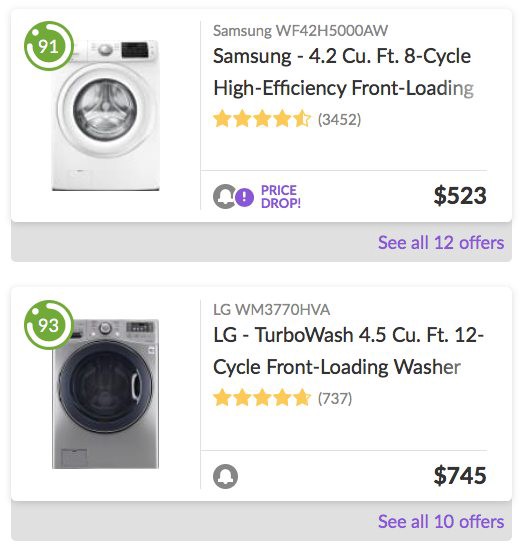Enervee created its product Marketplace in 2014, and in doing so launched the market for energy companies to offer their customers the opportunity to buy more efficient products and appliances for their homes. Today, Enervee Marketplace is used by utilities across the US and Europe to enable their customers to make better buying decisions. 45M electric households and 5.7M gas only households are able to do this now, at the last count.
We’re very proud of this achievement, not least because our data show that we as consumers do make better choices when we’re able to. In Enervee’s case, we empower consumers via features such as the Enervee Score and the Energy Savings Calculator — features designed to make energy use visible, salient and actionable for shoppers. Our thesis remains that it’s not necessary to reduce choice to only highly efficient products (choice editing) to drive efficient purchasing. Instead we need to make the better choices easier to make (improve the choice architecture. This view is what Cass Sunstein and Richard Thaler call Libertarian Paternalism — the use of behavioral science to adjust the choice environment so that choices that are better (for all of us) are easier to make, but where choice itself is not reduced in any way. This translates on Enervee Marketplace into consumers being able to buy even the least efficient 50-inch TV via the platform if they wanted to. Enervee is on delivering better choices, not fewer choices.
But the great thing is we as consumers tend to avoid low efficient products given that choice. Our research has shown that energy efficiency is now a key product attribute, alongside those attributes which traditionally have held the top spots — price and consumer reviews.
In short, we see clearly through our surveys and behavioral data that energy efficiency is no longer a niche quality attractive to a fringe of environmentally switched-on consumers.
Efficiency is mainstream for consumers, which in turn makes it a breakthrough marketing opportunity for manufacturers and retailers. So it’s no wonder that utilities and regulators see marketplaces as an exciting route to market transformation — marketplaces are now even mandated by regulators in forward-thinking states.
So it’s full steam ahead for marketplaces? Maybe.
Build it and they will come..?
Or maybe not. Whilst our research shows how important energy efficiency is as an attribute for consumers, this is not the same thing as saying it’s the most important attribute.
In our most recent research, we asked active consumers across the US which product attributes were important to their decision-making process [1]. The results chime with our earlier studies: efficiency performs well, pretty much going toe-to-toe with the more established attributes. When given six distinct product attributes to consider, 35.3% of consumers stated energy efficiency is an important criterion in the decision-making process, coming in behind price and consumer reviews (53.5% and 45.5% respectively; other attributes were brand (24.1%), warranty (22.3%)and retailer availability (11.8%).

To be clear, this validates Enervee’s decision to list these three elements — price, reviews and efficiency — on every product card on Marketplace.
In a follow-up question, though, we asked the same consumers to tell us which single attribute they’d use to search for a new purchase for their home. Price was the single most important attribute for over 33% of consumers polled. Consumer reviews were the second most important attribute for 24%. Energy efficiency, though, was the most important attribute for only 10.9% of consumers.
In other words, almost 90% of consumers would not use efficiency as a primary criterion by which to search for a new purchase.
This should cause pause for thought for utilities planning the launch of a marketplace for their customers: leading on efficiency may mean the vast majority of your customers never find your platform, because it doesn’t make the first cut in your customers’ decision journeys.
Put another way, efficiency is important in the consumer journey, but so is its position in the consumer journey.
Efficiency. Used efficiently.
All successful online businesses know the importance of securing the attention of the consumer at key moments in their online decision journey (see David Edelman’s influential re-drawing of the decision journey). One look at Amazon’s commitment to subsidise the prices of third-party vendors’ products without passing on that subsidy to the vendor shows how important Amazon thinks it is to secure attention early. We often only have one moment to make a difference, and that’s arguably nowhere more important than with driving more efficient choices.
We cannot afford to squander the opportunity to engage consumers in making more efficient choices, and this means using efficiency as a concept most efficiently within the consumer journey.
For marketplaces to be effective, they need to channel as much traffic as possible towards them. This means competing at the right moments on the attributes most likely to be used to steer choices early in the journey: price, reviews and brand are reported to make up three-quarters of search criteria in our research.
This in turn should cause utilities to think carefully whether a highly curated product offering on their marketplace is able to compete effectively on price, reviews and brand. This is the reason Enervee chooses instead to draw as wide a range of products from all major retailers to its platform, which in turn ensures best possible prices on the platform (it also means a wider choice of brands, models and reviews than even the largest single retailer).
That’s not to say utilities should completely avoid offering curated collections of products (possibly for direct sale), but that any such collections should be nested within the wider ‘whole market’ model. Enervee also provides this with its Checkout application, but looks to provide it always within the context of a marketplace which brings in products and prices daily from all leading retailers. It’s a strategic decision not to compromise to the consumer choice, but to enhance it, except where purchases may be so straightforward and routine, a curated (and direct purchase) option is indeed the better choice for the consumer (such as lightbulbs).
Influence is nothing without engagement
We know from our own projections that if we can influence just 30% of US consumers in a single year to make purchases with a 90+ Enervee Score across just five product categories, then the savings of those influenced choices amasses to 10,000GWh over those products’ lifetimes. That shows incredible potential, in terms of both energy savings (huge) and simplicity of intervention (short and once).
But two things are needed to affect change at that level. First, energy efficiency needs to be visible and actionable for consumers (we have plenty of evidence that the Enervee Score does this for all consumers). Second, the opportunity rests on securing as much consumer attention as possible at the right moment. Influencing 30% of US consumers isn’t going to happen if only 10.9% of US consumers consider the marketplace relevant in their decision journey. If we want to influence en masse, we have to engage en masse.
Of course, even providing consumers with a credible and compelling view of the entire market on marketplace will not bring 100% of shoppers to you (nice, though, that thought is). So engaging en masse means also layering energy efficiency over more established product attributes wherever shoppers are (less of a ‘build it and they will come’ model, and more of a ‘build it where they are’ one) . Enervee does this also, via its Charge application, where it provides retailers, manufacturers and publishers with product-specific energy efficiency information to embellish and augment all the other information consumers are looking for at that moment.
Providing a consumer experience that recognises the growing importance of efficiency, that understands how to make efficiency engaging and actionable, and that respects efficiency’s timing in the consumer decision journey, is key. These pieces together have the potential to unlock the true potential to change the way we buy — how we all buy. The route to transforming the market starts with understanding the consumer, and that has to involve appreciating when, where and how efficiency fits into the decision journey.
